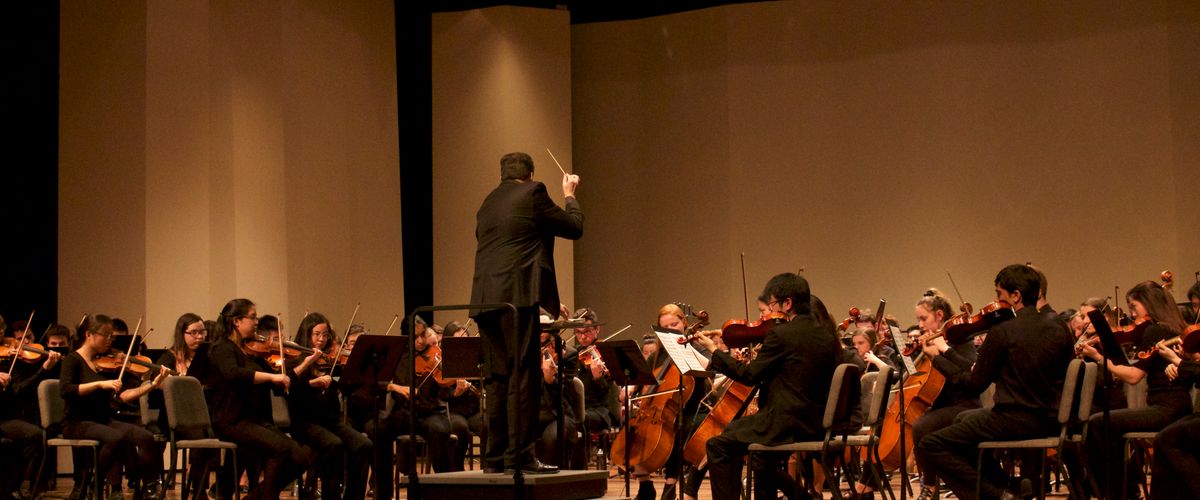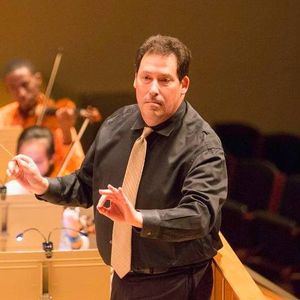All Campus Orchestra — 11.23.24
Boston University All-Campus Orchestra
Mark Miller, conductor
Maria Kurochkina, Teaching Assistant
Program
| Symphony No. 1 Op. 13, Mvt. 1 | Pyotr Tchaikovsky (1840 – 1893) |
| Callirhoe Suite, Prelude | Cécile Chaminade (1857-1944) |
| Autumn from The Seasons | Alexander Glazunov (1835-1921) |
Rosters
Boston University All-Campus Orchestra Fall 2024
| Violin 1 | |
| Abby Mercier | 2028, Education |
| Soyoung Bae | Grad 3rd Year, Molecular & Cellular Biology, Biochemistry |
| Sophie Choong | 2028, Data Science |
| Joshua Frank | 2028, Human Physiology |
| Michelle Kim | 2026, Biochemistry & Molecular Biology |
| Evan Leong | 2028, Data Science |
| Noel Leibly | 2025, Human Physiology |
| Carla Romney | |
| Michelle Yang | 2028, Biomedical Engineering |
| Yudi Zhang | 2028, Physics |
| Violin 2 | |
| Ocean Bruinius | 2027, Film and TV |
| Annie Chen | 2028, Psychology |
| Jessica Fessmann | 2025, Music |
| Nate Lee | 2028, International Relations |
| Noor Memarzadeh | 2027, Undecided in COM |
| Michaela Nuñez | 2027, Theory and Composition |
| Gavin Ng | 2028, Finance |
| Chelsea Panky | 2028, Business |
| Eunice Son | 2027, Biology |
| Anne Turmel | Grad 1st Year, Computer Science |
| Viola | |
| Anita Pira | 2028, Mechanical Engineering |
| Cello | |
| Amelia Andre | 2027, Neuroscience |
| Erin Cheng | 2025, Business administration, Concentration in information systems |
| Patrick Gong-Harjula | 2028, Biology |
| Isaac Hu | 2025, Computer Science |
| Yasheng Jiang | 2027, Physics |
| Sophia Lorenz | 2028, Biology with a Specialization in Cell Biology, Molecular Biology and Genetics |
| Frank Yang | 2027, Math and Computer Science |
| Bass | |
| Joshua Zimmer | 2028, Biomedical Engineering |
| Flute | |
| Madison Soares | 2025, Psychology/Religion |
| Sophia Wang | 2027, Biomedical Engineering |
| Abby Zimmerman | 2028, Composition |
| Oboe | |
| Angus Black | 2027, Music |
| April Li | Grad 1st Year, Music education |
| Barrett Schenk | 2025, Biomedical Engineering |
| Clarinet | |
| Daniel Cho | 2025, Mathematics |
| Joshua Kim | 2027, Data Science |
| Bassoon | |
| Andrew Lay | 2028, International Relations |
| French Horn | |
| Megan Carp | 2028, Music Performance |
| Alicia Hamm | 2026, Journalism |
| Trombone | |
| Mia Sandfort | 2028, Biology and German |
| Percussion | |
| Roscoe Branch | 2028, Undecided in CAS |
| Harp | |
| Zhuning Gao | 2028, Music Education |
| Velana Valdez | 2027, Neuroscience and Philosophy |
Program Notes
Symphony No. 1 Op. 13, Mvt. 1, Pyotr Tchaikovsky (1840 - 1893)
Tchaikovsky waited until his twenties before devoting himself to composition, quitting his CIvil Service law job to study music at the St. Petersburg Conservatory. In 1860s St. Petersburg, he would have heard the concerts given by Hector Berlioz, and the French composer’s innovations in orchestral color seem to have influenced the young Tchaikovsky. Aged 26, he accepted a faculty position at the new Moscow Conservatory, spending most of his spare time writing this symphony. He led to very long nights – he later developed a severe case of insomnia. His brother, the writer Modest Tchaikovsky, later said the First Symphony as the hardest for the composer to write. Mostly the Symphony seems to celebrate the romance of Winter – the briskness of a sled over fresh snow, the crispness of a cold morning, and even the warmth of a good fireplace. The first movement is titled Dreams of a Winter’s Journey and begins with the flute’s bird calls over a melancholic woodwind melody.
– Lansdowne Symphony Orchestra (edited)
Callirhoë Suite, Prelude, Cécile Chaminade (1857-1944)
The music for the ballet Callirhoë was to have been composed by Benjamin Godard, but he was busy with another project and offered it to Chaminade, who completed the work in 1887. Based on a poem by Anacreon, the scenario was written by Elzéard Rougier. Replete with twenty-two numbers (twenty-one in the piano-vocal reduction), the ballet was premiered on March 16, 1888, at the Grand Théâtre in Marseilles and received two hundred performances! Chaminade’s delightful music, from which she fashioned a four-movement suite, shows all the characteristic elements of her style: tuneful and memorable melodies, colorful evocations of nature scenes and “exotica,” lightly chromatic harmonies, and sparkling wit. The story, typical of French ballet for centuries, involves a “suspend-your-disbelief ” mythological story ideal for presenting much beautiful dancing and pageantry. The story concerns Greek warrior Alcméon, in love with captive princess Callirhoë, who is perceived as cold because she spurns his advances. The goddess Venus comes to his aid by turning her into a statue in a fountain, whose water will make anyone who drinks it forget their anguished love. He watches as goatherd Lycidas solves his similar problem by drinking and forgetting shepherdess Myrtha, who also drinks and forgets, and they both go off happily together. Alcméon won’t drink because he doesn’t want to forget his love for Callirhoë. Eventually Callirhoë, the statue, comes back to life, having forgotten his past behavior, and they happily unite. The four selections in the orchestral suite begin with the Prélude, a lovely, atmospheric pastorale that sets the scene—a landscape of oleander, olive trees, and pines with a statue of Venus in a fountain and the sea just visible beyond— and concludes with a section of merry wit.
– Jane Vial Jaffe
Autumn from The Seasons, Alexander Glazunov (1835-1921)
Glazunov’s musical score to choreographer Marius Petipa’s ballet Les Saisons (The Seasons) was first debuted in 1900. Autumn is the last of four tableaus, or scenes, depicted in the ballet. The opening phrase immediately brings life to the final, exuberant tableau, introducing dancers in a recurring melodic motif the ‘Autumn Bacchanale’. With its soaring melodic line and dance-like percussive foundation, the bacchanale conveys a celebratory portrayal of the autumnal season. Musical motifs from the spring movement are recalled with dolce melodies in the clarinet and flute, and the chirping of birds represented by oboe and piccolo. The centerpiece of the movement includes a significant romantic adagio section featuring solo instrumentalists as well as a prominent role for the harpist. The primary melody is presented, developed, then carried forth by various voices before each ascends, then dissolves, signifying the falling of the autumn leaves. The frolicking bacchanale motif returns once again, this time presented in triple meter variation. Near the end of the work, a robust line in the low brass conveys certainty of the changing seasons forthwith. Darkness and seeming instability gives way to a sense of ease and resolve, and the closing of the ballet ultimately reflects the celestial brightness of the collection of constellations that have hovered above earth throughout the ages.
– Julia Loshelder & Quinton Smith (edited)
Biographies
in alphabetical order

